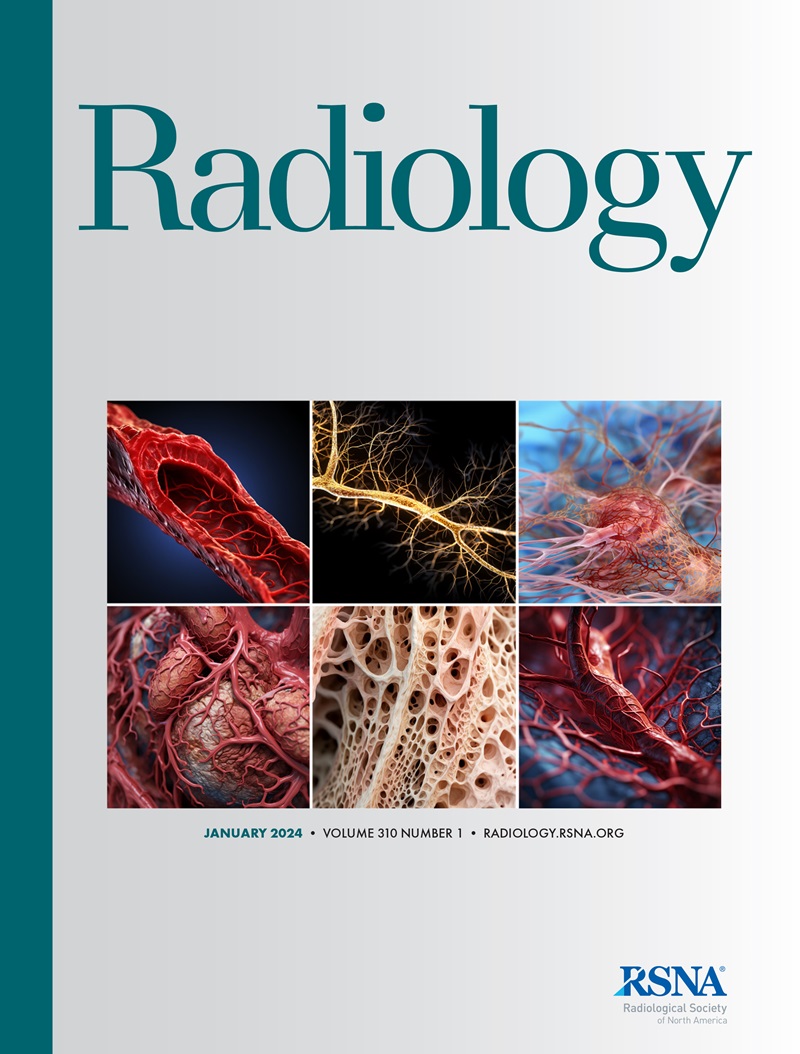求助PDF
{"title":"Impact of Background Parenchymal Enhancement on Diagnostic Performance of Breast MRI: A Systematic Review and Meta-Analysis.","authors":"Sonja Bechyna, Pascal A T Baltzer","doi":"10.1148/radiol.241919","DOIUrl":null,"url":null,"abstract":"<p><p>Background Breast MRI is the most sensitive modality for detecting breast cancer, but its diagnostic performance can be reduced by background parenchymal enhancement (BPE). However, the implications of the degree of BPE in diagnostic evaluation remain controversial due to conflicting evidence. Purpose To conduct a systematic review and meta-analysis to determine whether the presence of moderate or marked BPE in women undergoing breast MRI negatively affects diagnostic performance compared with minimal or mild BPE. Materials and Methods On May 6, 2024, a systematic review of PubMed and Google Scholar was conducted on studies assessing the diagnostic performance of contrast-enhanced MRI in detecting breast cancer. Studies published until May 2024 were included if they provided raw data to extract or calculate true-positive, false-positive, true-negative, and false-negative results. Data were integrated using a bivariate random-effects model, and the sensitivity and specificity were compared between minimal or mild and moderate or marked BPE. Sources of heterogeneity were explored using meta-regression analysis. Summary receiver operating characteristic analysis was performed to compare overall diagnostic performance at different BPE levels by using a <i>Z</i> test. Results Eight studies of 6044 women (mean age, 52 years) were included. Minimal or mild BPE was associated with higher sensitivity (95.3% vs 84.1%; <i>P</i> = .02) and higher specificity (89.0% vs 78.7%; <i>P</i> = .02) compared with moderate or marked BPE. Diagnostic performance was higher for minimal or mild BPE (area under the receiver operating characteristic curve [AUC], 0.95; 95% CI: 0.92, 0.96) compared with moderate or marked BPE (AUC, 0.91; 95% CI: 0.88,0.93; <i>Z</i> score, 2.69; <i>P</i> = .007). Moderate or marked BPE and publication year in cases of moderate or marked BPE were covariates influencing the diagnostic odds ratio. Moderate or marked BPE remained an independent predictor of the diagnostic performance at multivariable analysis (diagnostic odds ratio, -1.33; <i>P</i> = .002). Conclusion The degree of BPE influences the diagnostic performance of breast MRI, with minimal or mild BPE being associated with higher sensitivity and specificity and moderate or marked BPE being associated with lower diagnostic performance. © RSNA, 2025 <i>Supplemental material is available for this article.</i> See also the editorial by Bahl in this issue.</p>","PeriodicalId":20896,"journal":{"name":"Radiology","volume":"315 2","pages":"e241919"},"PeriodicalIF":15.2000,"publicationDate":"2025-05-01","publicationTypes":"Journal Article","fieldsOfStudy":null,"isOpenAccess":false,"openAccessPdf":"","citationCount":"0","resultStr":null,"platform":"Semanticscholar","paperid":null,"PeriodicalName":"Radiology","FirstCategoryId":"3","ListUrlMain":"https://doi.org/10.1148/radiol.241919","RegionNum":1,"RegionCategory":"医学","ArticlePicture":[],"TitleCN":null,"AbstractTextCN":null,"PMCID":null,"EPubDate":"","PubModel":"","JCR":"Q1","JCRName":"RADIOLOGY, NUCLEAR MEDICINE & MEDICAL IMAGING","Score":null,"Total":0}
引用次数: 0
引用
批量引用
Abstract
Background Breast MRI is the most sensitive modality for detecting breast cancer, but its diagnostic performance can be reduced by background parenchymal enhancement (BPE). However, the implications of the degree of BPE in diagnostic evaluation remain controversial due to conflicting evidence. Purpose To conduct a systematic review and meta-analysis to determine whether the presence of moderate or marked BPE in women undergoing breast MRI negatively affects diagnostic performance compared with minimal or mild BPE. Materials and Methods On May 6, 2024, a systematic review of PubMed and Google Scholar was conducted on studies assessing the diagnostic performance of contrast-enhanced MRI in detecting breast cancer. Studies published until May 2024 were included if they provided raw data to extract or calculate true-positive, false-positive, true-negative, and false-negative results. Data were integrated using a bivariate random-effects model, and the sensitivity and specificity were compared between minimal or mild and moderate or marked BPE. Sources of heterogeneity were explored using meta-regression analysis. Summary receiver operating characteristic analysis was performed to compare overall diagnostic performance at different BPE levels by using a Z test. Results Eight studies of 6044 women (mean age, 52 years) were included. Minimal or mild BPE was associated with higher sensitivity (95.3% vs 84.1%; P = .02) and higher specificity (89.0% vs 78.7%; P = .02) compared with moderate or marked BPE. Diagnostic performance was higher for minimal or mild BPE (area under the receiver operating characteristic curve [AUC], 0.95; 95% CI: 0.92, 0.96) compared with moderate or marked BPE (AUC, 0.91; 95% CI: 0.88,0.93; Z score, 2.69; P = .007). Moderate or marked BPE and publication year in cases of moderate or marked BPE were covariates influencing the diagnostic odds ratio. Moderate or marked BPE remained an independent predictor of the diagnostic performance at multivariable analysis (diagnostic odds ratio, -1.33; P = .002). Conclusion The degree of BPE influences the diagnostic performance of breast MRI, with minimal or mild BPE being associated with higher sensitivity and specificity and moderate or marked BPE being associated with lower diagnostic performance. © RSNA, 2025 Supplemental material is available for this article. See also the editorial by Bahl in this issue.
背景实质增强对乳腺MRI诊断性能的影响:系统回顾和荟萃分析。
乳腺MRI是检测乳腺癌最敏感的方式,但其诊断性能可能会因背景实质增强(BPE)而降低。然而,由于证据矛盾,BPE程度在诊断评估中的意义仍然存在争议。目的进行系统回顾和荟萃分析,以确定与轻度或轻度BPE相比,接受乳房MRI检查的女性中存在中度或显著性BPE是否会对诊断性能产生负面影响。材料与方法2024年5月6日,PubMed和谷歌Scholar对对比增强MRI检测乳腺癌诊断性能的研究进行了系统综述。在2024年5月之前发表的研究,如果提供了提取或计算真阳性、假阳性、真阴性和假阴性结果的原始数据,则纳入其中。使用双变量随机效应模型对数据进行整合,并比较轻度或轻度BPE与中度或显著BPE的敏感性和特异性。采用元回归分析探讨异质性的来源。通过使用Z检验,对不同BPE水平的总体诊断性能进行了总结接受者工作特征分析。结果共纳入8项研究,共6044名女性,平均年龄52岁。轻度或轻度BPE与更高的敏感性相关(95.3% vs 84.1%;P = .02)和更高的特异性(89.0% vs 78.7%;P = .02)。轻度或轻度BPE的诊断效能更高(受试者工作特征曲线下面积[AUC], 0.95;95% CI: 0.92, 0.96)与中度或重度BPE (AUC, 0.91;95% ci: 0.88,0.93;Z值为2.69;P = .007)。中度或显著性BPE和中度或显著性BPE病例的发表年份是影响诊断优势比的协变量。在多变量分析中,中度或显著的BPE仍然是诊断表现的独立预测因子(诊断优势比,-1.33;P = .002)。结论BPE的程度影响乳腺MRI的诊断效能,轻度或轻度BPE的敏感性和特异性较高,中度或明显BPE的诊断效能较低。©RSNA, 2025本文可获得补充材料。请参阅Bahl在本期的社论。
本文章由计算机程序翻译,如有差异,请以英文原文为准。

 求助内容:
求助内容: 应助结果提醒方式:
应助结果提醒方式:


